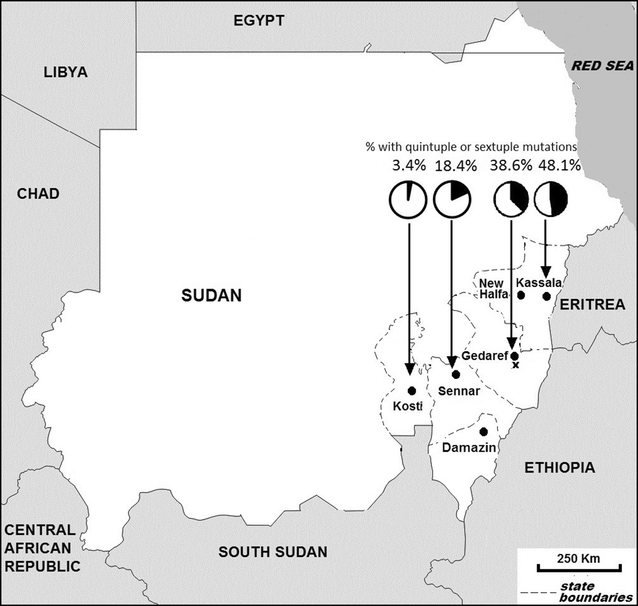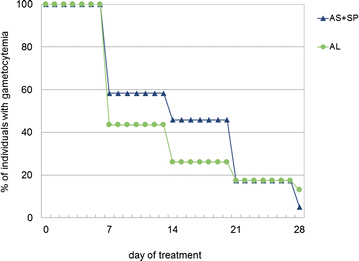High efficacy of artemether-lumefantrine and declining efficacy of artesunate + sulfadoxine-pyrimethamine against Plasmodium falciparum in Sudan (2010-2015): evidence from in vivo and molecular marker studies
- PMID: 27209063
- PMCID: PMC4875683
- DOI: 10.1186/s12936-016-1339-x
High efficacy of artemether-lumefantrine and declining efficacy of artesunate + sulfadoxine-pyrimethamine against Plasmodium falciparum in Sudan (2010-2015): evidence from in vivo and molecular marker studies
Abstract
Background: The present paper reports on studies that evaluated artesunate + sulfadoxine-pyrimethamine (AS + SP) which is the first-line drug and artemether-lumefantrine (AL) which is a second-line drug against uncomplicated falciparum malaria in Sudan. This evaluation was performed in twenty studies covering six sentinel sites during five successive annual malaria transmission seasons from 2010 to 2015.
Methods: The standard World Health Organization protocol was used for a follow-up period of 28 days. The frequency distribution of molecular markers for antifolate resistance in dihydrofolate reductase (dhfr) and dihydropteroate synthase (dhps) genes was studied in pre-treatment samples in four sites in 2011.
Results: In the nine studies of AL conducted at five sites (n = 595), high PCR-corrected cure rates were found, ranging from 96.8 to 100 %. Among the eleven studies of AS + SP (n = 1013), a decline in the PCR-corrected cure rates was observed in Gedaref in Eastern Sudan: 91.0 % in the 2011-12 season and 86.5 % in the 2014-15 season. In the remaining sites, the AS + SP cure rates ranged between 95.6 and 100 %. The rate of clearance of microscopic gametocytaemia after treatment was not significantly different with AL or AS + SP on days 7, 14, 21 and 28 of follow-up. A total of 371 pre-treatment samples were analysed for molecular markers of SP resistance. The temporal changes and geographical differences in the frequency distribution of SP-resistance genotypes showed evidence of regional differentiation and selection of resistant strains.
Conclusion: The findings of this study call for a need to review the Sudan malaria treatment policy. Epidemiological factors could play a major role in the emergence of drug-resistant malaria in eastern Sudan.
Australian new zealand clinical trials registry: Trial registration numbers 2011-2012: ACTRN12611001253998, 2013-2015: ACTRN12613000945729.
Keywords: Artemether-lumefantrine antimalarial drugs; Artesunate; Drug resistance; Molecular markers; Sudan; Sulfadoxine-pyrimethamine; dhfr; dhps.
Figures


Similar articles
-
Efficacy of artesunate + sulphadoxine/pyrimethamine and artemether + lumefantrine and dhfr and dhps mutations in Somalia: evidence for updating the malaria treatment policy.Trop Med Int Health. 2017 Apr;22(4):415-422. doi: 10.1111/tmi.12847. Epub 2017 Feb 24. Trop Med Int Health. 2017. PMID: 28151566
-
Comparative efficacies of artemisinin combination therapies in Plasmodium falciparum malaria and polymorphism of pfATPase6, pfcrt, pfdhfr, and pfdhps genes in tea gardens of Jalpaiguri District, India.Antimicrob Agents Chemother. 2012 May;56(5):2511-7. doi: 10.1128/AAC.05388-11. Epub 2012 Feb 6. Antimicrob Agents Chemother. 2012. PMID: 22314538 Free PMC article. Clinical Trial.
-
Sustained efficacy of artesunate-sulfadoxine-pyrimethamine against Plasmodium falciparum in Yemen and a renewed call for an adjunct single dose primaquine to clear gametocytes.Malar J. 2016 May 27;15(1):295. doi: 10.1186/s12936-016-1344-0. Malar J. 2016. PMID: 27234587 Free PMC article.
-
Systematic Review and Geospatial Modeling of Molecular Markers of Resistance to Artemisinins and Sulfadoxine-Pyrimethamine in Plasmodium falciparum in India.Am J Trop Med Hyg. 2024 Apr 2;110(5):910-920. doi: 10.4269/ajtmh.23-0631. Print 2024 May 1. Am J Trop Med Hyg. 2024. PMID: 38574550 Free PMC article.
-
Artemether-lumefantrine for treating uncomplicated falciparum malaria.Cochrane Database Syst Rev. 2003;(2):CD003125. doi: 10.1002/14651858.CD003125. Cochrane Database Syst Rev. 2003. Update in: Cochrane Database Syst Rev. 2007 Jul 18;(2):CD003125. doi: 10.1002/14651858.CD003125.pub2. PMID: 12804451 Updated.
Cited by
-
Genetic polymorphism of the N-terminal region in circumsporozoite surface protein of Plasmodium falciparum field isolates from Sudan.Malar J. 2019 Oct 1;18(1):333. doi: 10.1186/s12936-019-2970-0. Malar J. 2019. PMID: 31570093 Free PMC article.
-
Molecular surveillance of putative drug resistance markers of antifolate and artemisinin among imported Plasmodium falciparum in Qatar.Pathog Glob Health. 2019 Jun;113(4):158-166. doi: 10.1080/20477724.2019.1639018. Epub 2019 Jul 12. Pathog Glob Health. 2019. PMID: 31296112 Free PMC article.
-
Assessment of Plasmodium falciparum drug resistance molecular markers from the Blue Nile State, Southeast Sudan.Malar J. 2020 Feb 18;19(1):78. doi: 10.1186/s12936-020-03165-0. Malar J. 2020. PMID: 32070355 Free PMC article.
-
Therapeutic Efficacy of Artemether-Lumefantrine (Coartem®) for the Treatment of Uncomplicated Falciparum Malaria in Africa: A Systematic Review.J Parasitol Res. 2020 Oct 20;2020:7371681. doi: 10.1155/2020/7371681. eCollection 2020. J Parasitol Res. 2020. PMID: 33145101 Free PMC article. Review.
-
Therapeutic efficacy of artesunate-amodiaquine and artemether-lumefantrine for the treatment of uncomplicated falciparum malaria in Chad: clinical and genetic surveillance.Malar J. 2023 Aug 23;22(1):240. doi: 10.1186/s12936-023-04644-w. Malar J. 2023. PMID: 37612601 Free PMC article.
References
-
- WHO. World malaria report, 2014. Geneva: World Health Organization; 2014.
-
- Adeel AA. Drug-resistant malaria in Sudan: a review of evidence and scenarios for the future. Sudan J Paediatr. 2012;12:8–20. http://www.sudanjp.org/uploads/9/2/7/0/9270568/drug-resistant_malaria_in.... - PMC - PubMed
-
- A-Elbasit I, Elbashir M, Khalil I, Alifrangis M, Giha H. The efficacy of sulfadoxine-pyrimethamine alone and in combination with chloroquine for malaria treatment in rural Eastern Sudan: the interrelation between resistance, age and gametocytogenesis. Trop Med Int Health. 2006;11:604–612. doi: 10.1111/j.1365-3156.2006.01616.x. - DOI - PubMed
-
- WHO. Methods for surveillance of antimalarial drug efficacy. Geneva: World Health Organization; 2009. http://www.who.int/malaria/publications/atoz/9789241597531/en/. Accessed 23 Oct 2015.
MeSH terms
Substances
Associated data
Grants and funding
LinkOut - more resources
Full Text Sources
Other Literature Sources
Research Materials
Miscellaneous

